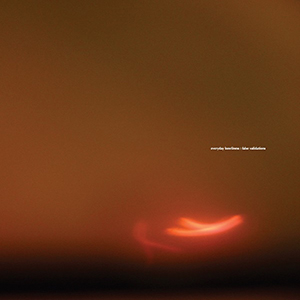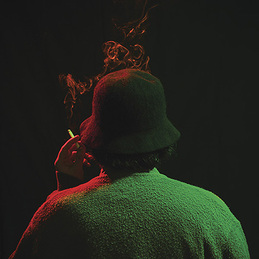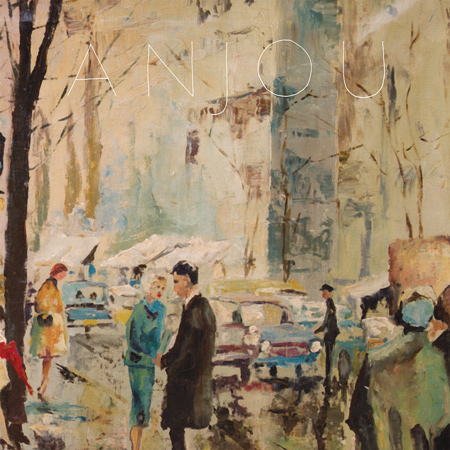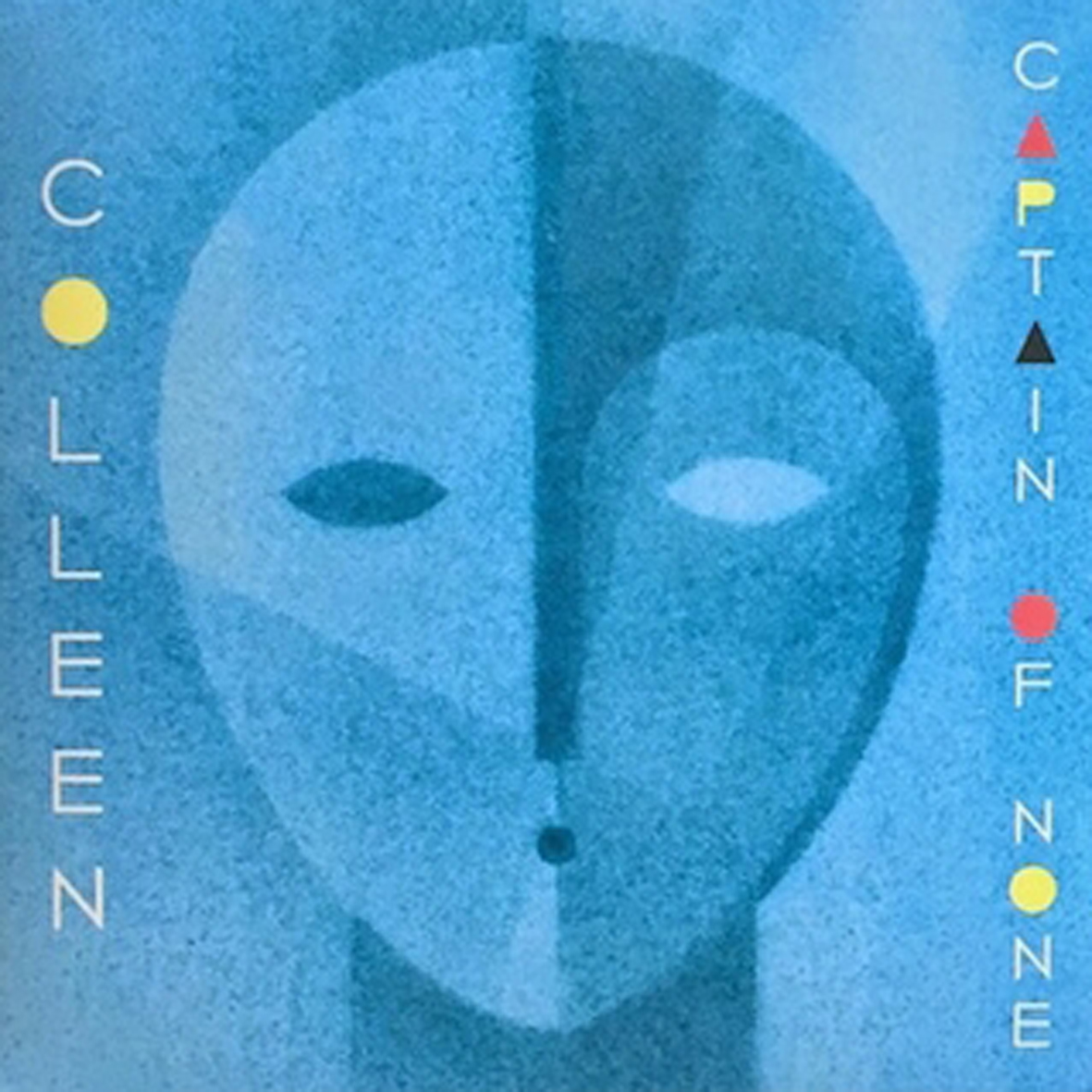- Administrator
- Albums and Singles
 Jon Borges, who also records as half of Pedestrian Depot, has chosen a project name that is only partially fitting for the sound he creates. While the Loneliness part is most fitting, given its isolated and depressing sound, the Everyday part maybe not so much. False Validations is a standout within a field of frigid waves and minimalist drone, the sound of beautiful depression.
Jon Borges, who also records as half of Pedestrian Depot, has chosen a project name that is only partially fitting for the sound he creates. While the Loneliness part is most fitting, given its isolated and depressing sound, the Everyday part maybe not so much. False Validations is a standout within a field of frigid waves and minimalist drone, the sound of beautiful depression.
This is clearly a "genre" record that is focusing on, and embracing a very specific style and sound.In this case that sound is a suite of beautiful, yet lonely stretches of sparse electronics.The sparseness can be highly misleading though:"What Doesn't Belong" has a lengthy and constant sound throughout, but Borges builds the piece layer by layer, going from a thin drone to a heavy, rich piece that emphasizes all ends of the sonic spectrum.
The 11 minute "Pretender" has Borges using its duration to build from a cold, shimmering passage of sound into a more complex, heavy composition that manages to be simple, yet gripping.As my attention drifted in and out on my first time through the record, each time it came back I was struck at how much the piece had evolved and expanded from only moments before."No Permission Sought or Given" is still a beautiful piece of sound, but darkness enters the picture here.What sounds almost like echoing crashes in the far off distance is blending with ominous, humming electronics.Here the loneliness is enhanced by an additional ambiguous bleakness, with just a hint of evil.
The final two songs are no less isolating, but become darker and more dissonant as they conclude the album."Stasis Interlude" is still just as minimalist as the rest, but a hint of distortion enshrouds the electronics, at times a passage resembling a jet plane flying far off in the distance.The concluding "The Source's Ghost" is pushed further into darkness during its few minutes.Compared to the remainder of the album, it has a murky, sinister sound at first, and then becomes richer, heavily filtered and layered while still staying powerfully simple.Borges again cautiously utilizes distortion and noise to give texture to the piece, without offsetting its lonely and beautiful sound.
False Validations is not an easy record, being two vinyl sides of sparse, yet lovingly treated electronics and minimalist structures.It is not abrasive or harsh as a whole, but it is also the type of record that requires attention to fully appreciate.When given the intention, it is a gripping and intense, if somewhat depressing experience that is, as suggested, best experienced alone in a dark room.
samples:
 
Read More
- Administrator
- Albums and Singles

Cascade and The Deluge are variations on the latest tape-loop and delay composition from the inimitable William Basinski. Cascade is the CD/Digital variant, and The Deluge is the vinyl LP companion.
In Cascade, a single ancient lilting piano tape loop repeats endlessly carrying one along in its tessellating current.
In The Deluge, the same loop is processed through a series of feedback loops of different lengths, creating a spiraling crescendo of overtones that eventually fades away to silence. In the denouement, a series of limpid piano loops leads to an urgent orchestral theme that builds and gradually dies.
More information can be found here.

Read More
- Administrator
- Albums and Singles

"I traced
the convolutions of
turf, laid out by men,
& made new windings with the mole
through undisturbed
barrows."
(Ronald Johnson, "The Book of the Green Man")
Belated Movements for an Unsanctioned Exhumation August 1st 1984 is Richard Skelton's second album as The Inward Circles, following 2014's Nimrod is Lost in Orion and Osyris in the Doggestarre. If his previous offering hovered "between the empyreal and the subterranean," Belated Movements is resolutely earthbound, beginning at ground level and slowly moving ever downward. The title is a reference to "Lindow Man," one of many bog bodies discovered in northern Europe in the twentieth century, and continues an archaeological theme which first surfaced in his 2013 *AR collaboration with Autumn Richardson, entitled Succession. In particular, it is the last composition from that album, Relics, which can now be seen as starting point for much of Skelton's future work as The Inward Circles. But whereas Relics dealt with the pollen remnants submerged beneath tarns in the remote Cumbrian uplands, Buried Movements evokes a distinctly funerary landscape.
The first piece, "Petition for Reinterment" begins in familiar terrain - a slow, solemn string elegy - but it gently begins to disintegrate, to distend and rot, as if the music itself is being subsumed in soil and subjected to the natural cycles of decay and renewal. It is interesting to note that, whilst the skin of bog-bodies is often very well preserved, the bones undergo a process of decalcification - they literally dissolve from within. But exhumations such as "Lindow Man" are now artificially preserved behind museum glass, removed from time, from earthly contact and the inexorable progress of nature itself.
By contrast, the music of Belated Movements continues its inner transformation, and "To Your Fox-Skin Chorus" divulges more of its innards, revealing hitherto unheard melodic, rhythmic and textural material. The reference to fox-skin, borrowed from Edmund Gosse, alludes to the fox-fur arm-covering found on "Lindow Man," and, more obliquely, to the fox as a psychopomp - a soul guide - which formed a central theme in Skelton's recent Feræ Naturæ book and exhibition.
The album concludes with a further downward delving to the bones of animals long made extinct in England by humans: the wolf, lynx and bear - animals that haunt the popular imagination. Here the music is at its most restless and forbidding, as it ends with an urgent call - Canis, Lynx, Ursus: Awake, Arise, Reclaim. There is a palpable sense, with its almost unbearable crescendo, of a rising up, a return to the surface, and a threatening quiet.
BELATED MOVEMENTS FOR AN UNSANCTIONED EXHUMATION AUGUST 1ST 1984
by The Inward Circles
1. Petition for Reinterment
2. To Your Fox-Skin Chorus
3. Canis, Lynx, Ursus: Awake, Arise, Reclaim
Total Running Time : 60mins
More information can be found here.
Read More
- Administrator
- Albums and Singles

2015, and the silence has been broken with Simple Songs. Jim O'Rourke is ready to talk to you again. First, he wants you to know he's not dead...yet. But you're not, either-and really, what have you done lately? Certainly not made your first pop album since 2001-and even if you had, it probably wasn't any good. Meanwhile Simple Songs is more than just a first of anything since whenever! It's an amazing record of musical song entertainment-because Jim O'Rourke knows what he wants and how to get it...musically, that is. The rest of the world is still a mystery and a bottomless source of aggravation for the old boy. What do we care? We get a great new album out of it.
Yes, Simple Songs is an album of songs sung by Jim O'Rourke
All the way through! It has been ten years since Jim's voice rang out from a new album. What Simple Songs sounds like.... At this point, the range of sounds and songs that have turned Jim's head are numerous enough to have crushed together into something that is unmistakably his-the vast, glossy and glittering
O'Rourkian (yes, like Kervorkian) wall of sound. The music's got OCD quality, played so immaculately by so many instruments, and most of them by the creator's hand. This time's really the widest screen yet for Jim's popular song-style, truly breathtaking! Simple Songs was worked over, from source material to finished mix, for five years or more now.
Jim's writing is kinda rooted in the approach of Insignificance-frosted pop tarts that leave a darkly bitter aftertaste.
Let Simple Songs seep into your brain, as a musical expression on May 19th! Most of all though, don't hate this or he'll go away again for another decade!
Jim's got just what the world needs now-but who needs you?
More information is available here.
Read More
- Administrator
- Albums and Singles

Backwards is very happy to announce the NEW My Cat Is An Alien studio double-album!
From the extended foreword insert by David Keenan: "What are we to make of My Cat Is An Alien, the duo of the brothers Roberto and Maurizio Opalio, titling this new extended sound work The Dance Of Oneirism? [...] None of the tracks have titles; instead we feel our way by number, by movement. Our co-ordinates are fixed, or more properly suggested, by the listing of instruments. Self-made double-bodied string instrument, handmade pocket harp, pedal effects, wordless vocalizations, modified analog drum machine, mini-keyboard, alientronics. But even here nothing is straightforward; everything is invented, shrunken, self-built, inchoate: alien-ated. The session was recorded – instantly composed – in MCIAA's "Alien Zone," situated in the Western Alps, and it sounds it. The central fact of MCIAA's music has always been space but they have never sounded quite so far away, so removed. [...] The music is extremely sensual. The rhythms have a contrary cold/organic quality to them, the feel of the pulse as the breath is held, but soon even that dies down and we are left with an extended, timeless moment, the space between one breath and the next. Occasionally there is the sound of strings, strange steel resonances that populate the music like ghosts, the ghosts of Roscoe Holcomb's high, lonesome sound, of Dock Boggs and the sanctified steel of Washington Phillips. Ash Ra Tempel met Timothy Leary in the Alps [...] The transmissions are fuzzy up here and at points it makes for a music of almost terrifying quiet. It is minimal, sure, but MCIAA are not so much interested in repetition as in eternal expansion. [...] The Dance Of Oneirism is a music of unknowing, a dance with a phantom, the letting go of a dream. It is MCIAA's greatest long form work. It has tributaries that run deep into the past, ghost channels that facilitate two-way travel, even as its destination, in the words of the late Conrad Schnitzler, is determinedly future, future, future." - David Keenan
Includes a photographic Art Book by Roberto Opalio. Silkscreened image by the artist on Side D. In first 80 copies LP1 and LP2 come each in different colours.
More information is available here.
Read More
- Administrator
- Albums and Singles

Re-issue of the AMM tape recorded between 1981 and 1985 by JD Emmanuel, a new age composer who has received a lot of praise from people like Lieven Martens and John Olsen.
These recordings signify Emmanuel's praise to the course of the day. Starting off slowly, with morning synth meanderings, walking through midday, running in the evening and closing the day with midnight meditation.
"Somewhere hidden in the deepest part of the Self is that special place, where One can go within to the most ancient part of one's Self and connect with the origin of Self. Ancien Minimal Meditations reaches into that special place of creation of the Self and its Oneness with the Creator of All."
Side One:
Morning Worship (5:26)
Midday Attunement (12:33)
Side Two:
Evening Devotional (7:12)
Midnight Meditation (10:27)
Recorded using three Sequential Circuits Pro-One synthesizers and a Yamaha SK-20 Poly-Synthesizer.
- * Limited to 400 copies
- * Full color thick cardboard sleeve
- * 180 gr. vinyl
- * 100% Analogue sound
- * Mastered by JD Emmanuel
More information is available here.
Read More
- Administrator
- Albums and Singles

Enigmatic faces stare out from tableaux on walls and caves.
Impenetrable and mysterious they haunt the mind.
On the last edge of vibration they cross.
Unwelcomed and uninvited. A murmur in a shadow.
A last breath.
They have a tendency to walk through walls.
Wheels of fire spit flames into the night.
A dark road echoes.
The stars vanish.
A face in darkness shines.
A ribbon on a trace weed.
The last curl of smoke.
Eyes wide and seeing.
They came.
More information is available here.
Read More
- Administrator
- Albums and Singles

ÜTOPIYA? not only continues Oiseaux-Tempête's first album, but it extends it. The travels move this time to Istanbul and Sicily providing the food for its urgent energy and indomitable drive. While the structures still hint at moments of post-rock, they go further now, almost into the area of free-jazz yet without losing a directness rooted in punk (highlighted perhaps by the presence of G.W.Sok from The Ex). In addition, the bass clarinet of Gareth Davis references both the roughest of experiments of Akosh Szelevényi and of The Stooges Fun House.
More information can be found here.
Read More
- Administrator
- Albums and Singles
 All art, whether by design or by accident, contends with time. But music’s relationship to it, like cinema’s, is pronounced, as is evident in the case of Anjou. On their Kranky debut, ex-Labradford members Mark Nelson and Robert Donne join Haptic’s (and Innode’s and Pan•American’s) Steven Hess for eight melancholy preludes focused on form, color, light, and time. Their songs are short, no longer than nine minutes, and expressionistic, dotted with half-heard rhythms and implied melodies orbiting a tonal center. They issue into the room in suspended animation and hang there mysteriously, heavy like a storm cloud. In them, the passage of time ceases to mark minutes and seconds and instead denotes the availability of different perspectives. Sounds are typically thought of as moving through spaces, but in this case spaces move through sounds, guided in their course by a trio of directors with an impossible view from above.
All art, whether by design or by accident, contends with time. But music’s relationship to it, like cinema’s, is pronounced, as is evident in the case of Anjou. On their Kranky debut, ex-Labradford members Mark Nelson and Robert Donne join Haptic’s (and Innode’s and Pan•American’s) Steven Hess for eight melancholy preludes focused on form, color, light, and time. Their songs are short, no longer than nine minutes, and expressionistic, dotted with half-heard rhythms and implied melodies orbiting a tonal center. They issue into the room in suspended animation and hang there mysteriously, heavy like a storm cloud. In them, the passage of time ceases to mark minutes and seconds and instead denotes the availability of different perspectives. Sounds are typically thought of as moving through spaces, but in this case spaces move through sounds, guided in their course by a trio of directors with an impossible view from above.
When it comes to melody, Anjou is all dark, thickly applied colors. It makes more sense to talk about the album’s latent melodies actually, as many of its songs, like "Lamptest" and "Readings," begin and end in nearly the same place with minimal development happening in between. They don’t move along linearly, from left to right, they vibrate in place or hum from top to bottom, congealing ultimately as textures, not as melodic lines. What distinct melodies there are generally fall by the wayside, usurped by stereoscopic radiation that bleeds out into fields of deep red, blue, and purple, all reverberating on an imposing black canvas.
A sense of darkness and of concealment permeates the entire album, from the structural level down to the instrumental, where fragmented or otherwise murky sediment constantly works to disguise the music’s formal features. The structure of each song is easy enough to spot. There is the looped synthesizer, the guitar feeding back on itself, the electronic drums beating softly in the background, static interference, live percussion, and sudden, solitary chords that open up in the noise like valleys opening up in the mountains. These are repeated, subdued, emphasized, distended, or otherwise modified in different ways, just enough to create a sense of movement, a sense that something is about to take shape. What that is never becomes clear, however. The shapes turn to shadows, the shadows to blurry movements, and the movements themselves to doubtful illusions.
The song titles all point in this direction either directly or obliquely: "Lamptest" and "Backsight" in the sense of shining a light on things and peeling back the dark, or at least trying to; "Readings" and "Adjustment" in the sense of interpreting something unclear; and "Sighting" and "Inclosed" in the sense of what can and can’t be seen, no matter how hard one looks. Because Anjou is so strongly visual —and because it is so effective at focusing the ear on a place where melody, rhythm, and texture meet— time is frozen and highlighted, made conspicuous in its subordination to space, color, and light. These songs don’t unfurl, they shift focus, as if a camera were recording them by moving up and down the length and width of a musical object. What we hear is just a small section of some endless unknown thing vibrating out in all directions. In this way time is made equal to space. It becomes an extra dimension and not just a series of hash marks reminding us that something was here once, but is now gone. Music has always made time available to the ears. On Anjou, Nelson, Donne, and Hess transpose it for the eyes.
samples:
 
Read More
- Administrator
- Albums and Singles
 Back in 2013, Cécile Schott unexpectedly ended a very long hiatus in appropriately unexpected style by reinventing herself as an eccentric, viola da gamba-wielding singer/songwriter.  Captain of None is both a continuation and refinement of that vein, but with an additional twist: Schott has found a way to subtly integrate her love of Jamaican dub techniques into the Colleen sound.  That turned out to be a great idea, as I have already seen Captain compared to Arthur Russell's World of Echo more than once.  While it does not all that sound much like Russell stylistically, Schott's hushed and poetic pop experiments are similarly idiosyncratic and starkly intimate.  Also of note: Captain of None is yet another absolutely stellar Colleen album.
Back in 2013, Cécile Schott unexpectedly ended a very long hiatus in appropriately unexpected style by reinventing herself as an eccentric, viola da gamba-wielding singer/songwriter.  Captain of None is both a continuation and refinement of that vein, but with an additional twist: Schott has found a way to subtly integrate her love of Jamaican dub techniques into the Colleen sound.  That turned out to be a great idea, as I have already seen Captain compared to Arthur Russell's World of Echo more than once.  While it does not all that sound much like Russell stylistically, Schott's hushed and poetic pop experiments are similarly idiosyncratic and starkly intimate.  Also of note: Captain of None is yet another absolutely stellar Colleen album.
If there was a prize for "Least Jamaican-Sounding Album," it is hard to imagine Captain of None not at least making the short-list, as Schott's incorporation of dub techniques is only that: Colleen still sounds far more like an early music ensemble than like King Tubby.  Well, for the most part, anyway–there are three exceptions.  The first is the bittersweetly melancholy "Salina Stars," which beautifully augments Schott’s plucked bass line with a bleary, echoing melodica melody that unavoidably calls to mind a heartbroken Augustus Pablo.  The secondly distinctly "dub" moment is the mostly a capella "This Hammer Breaks," which sounds like a modern spiritual beset by some very busy and clattering Muslimgauze-style percussion. The last recognizable stylistic nod to Jamaica ("Eclipse") actually seems like a legitimate stab at dub-reggae, boasting a fluid bass pulse; ghostly, dissolving vocals; and clattering, panning percussion flourishes.  Nevertheless, it remains distinctly Colleen-ified, as the hyper-minimal music is just a very simple viola da gamba pattern endlessly repeated.  For the remainder of the album, Colleen's studio enhancements are just that, seamlessly adding a haze of warm reverb to Cécile’s plucked arpeggios and a patina of deliciously blurred unreality to some otherwise very minimal and direct music that is distinctively, singularly "Colleen."
While the aforementioned "Salina Stars" is a definite highlight in its own right, Captain's greatest moments are its bookends: the opening instrumental "Holding Horses" and the closing title piece.  Bass plucks aside, "Horses" sounds a lot like a rippling, neo-classical harp piece, albeit one where the twinkling arpeggios are trailed by burbling, hallucinatory after-images and warm washes of reverb.  It is quite a stunning feat, as there is so little actually being played (only the bass part has any perceptible melodic motion), yet the piece feels like a shimmering, vibrant, and multilayered tour de force.  "Captain of None" achieves a similar feat of improbable alchemy, maintaining an insistently repeated pattern of just a few notes for the entire song, but filling the spaces with a soft-focus haze of delay and gradually ratcheting up the intensity with some very unusual percussion.  Also, Schott's repeating and minimal lyrics ("captain of nothing, captain of none") gradually take on the hypnotic feel of a mantra as the piece builds in power.  Yet again, Schott manages to be absolutely captivating with just a handful of notes.
The remaining pieces are quite memorable as well, if varied.  The infectiously melodic "Soul Alphabet," for example, sounds like a jaunty bit of steel-guitar Americana transposed to warmly finger-plucked viola da gamba.  "Lighthouse" eventually arrives in a similar place after a lengthy introduction, but augments its rolling and rootsy crescendo with blurred and spectral layers of frayed angelic vocals.  Elsewhere, the minor key "I'm Kin" is a darker variation of the "Captain of None" aesthetic.  Though it does not work quite as well as the title piece, it highlights yet another fascinating element of Captain of None: Cécile’s cryptic and poetic lyrics are a huge part of the album's sublimely alien mystique, eschewing anything remotely mundane for meditations on Argos and kinship with stones and ice (and dogs hanging from trees).  It is frankly easier to imagine this music being made by a Siren than by a regular human, as everything about it seems completely and effortlessly detached from our current time and place.  Also, its directness and guileless simplicity seems too weirdly pure to come from anyone who has not been silently living in a cave or monastery for decades.  The only real critique I can muster is that Captain of None basically sounds like mermaid washed up on the shore to unleash bizarre, crystalline pop perfection upon the world, but only achieved it about half the time.  The rest is merely very good.
Samples:
 
Read More
- Administrator
- Albums and Singles

After a break of 5 years, Alva Noto continues his "Xerrox" series with Xerrox Vol. 3, entitled "Towards Space," a journey that started with Xerrox Vol. 1, referring to the "old world," and Xerrox Vol. 2, heading "to the new world."
Using the process of copying as a basis, the "Xerrox" series deals with the manipulation of data by means of endless reproduction. due to the inherent vice of the procedure that becomes especially visible when copies are made from copies, everyday sounds are so much altered that they can be hardly associated with the source material anymore. as a result, entirely new sounds are created that, being copies of originals, become originals themselves.
On Xerrox Vol. 3, a new aspect enters the scene. inspired by childhood film memories from the 1970s including Tarkovsky‘s adaption of Solaris and La Isla Misteriosa y el Capitán Nemo based on Jules Verne's "The Mysterious Island," the record shows Alva Noto's private side. with its very intimate atmosphere, it is a personal reflection of dreams, an imaginary journey through emotional landscapes or, as he himself puts it, a "cinematographic emotion of a soundtrack to a film that actually does not exist in reality."
Alva Noto himself further states, "I see Xerrox Vol. 3 as my most personal album so far. I have to admit that this emotional output is a surprise even for myself. it remains exciting how the last two albums of this series will sound like."
More information can be found here.
Read More